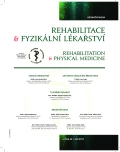Constraint Induced Movement Therapy Patients after Stroke
Authors:
P. Horsáková; M. Krivošíková; O. Švestková
Authors‘ workplace:
Klinika rehabilitačního lékařství 1. LF UK a Všeobecné fakultní nemocnice v Praze
přednostka doc. MUDr. O. Švestková, Ph. D.
Published in:
Rehabil. fyz. Lék., 24, 2017, No. 3, pp. 166-169.
Category:
Original Papers
Overview
There is a typical tendency of not using paretic upper extremity in daily activities after stroke. Avoiding the use of upper extremity may cause a gradual deterioration of its motor function. Constraint induced movement therapy is a set of methods used with patients after damage of central nervous system. It is applied by different health care professions, one of them is occupational therapy. Intensive training of paretic upper extremity, combination of isolated excercises and activities of daily living and therapy quantification are the main advantages of this therapeutic method.
Application of behavioral methods in therapy is also an integral part of this method to ensure greater involvement of the patient in therapy process and also in home training.
KEYWORDS:
constraint induced movement therapy, stroke, neurorehabilitation, upper extremity
Sources
1. ATLER, K. et. al.: A follow-up study on the relationship among participation, activity and motor function in survivors of stroke following constraint-induced therapy. Disability and Rehabilitation [online], 37, 2014, 2, s. 121-128 [cit. 2016-11-28]. DOI: 10.3109/09638288.2014.910560. ISSN 0963-8288. Dostupné z: http://www.tandfonline.com/doi/full/10.3109/09638288.2014.910560.
2. DROMERICK, A. W., EDWARDS, D. F., HAHN. M.: Does the application of constraint-induced movement therapy during acute rehabilitation reduce arm impairment after ischemic stroke? Stroke [online],31, 2000, 12, s. 2984-2988 [cit. 2017-01-26]. DOI: 10.1161/01.STR.31.12.2984. ISSN 0039-2499. Dostupné z: http://stroke.ahajournals.org/cgi/doi/10.1161/01.STR.31.12.2984.
3. INCE, L. P.: Escape and avoidance conditioning of responses in the plegic arm of stroke patients: A preliminary study. Psychonomic Science [online]. 16, 1969, 1, s. 49-50 [cit. 2016-11-26]. DOI: 10.3758/BF03331910. ISSN 0033-3131. Dostupné z: http://link.springer.com/10.3758/BF03331910.
4. LÁSKÁ, K., BAUKO T.: Efekt constraint induced movement therapy (terapie vynuceného používání) u pacientů s hemiparézou v chronickém stadiu onemocnění. Neurologie pro praxi [online.. 17, 2016, 1, s. 51-55 [cit. 2016-11-26]. Dostupné z: http://www.neurologiepropraxi.cz/pdfs/neu/2016/01/10.pdf.
5. LUM, P. et al.: Automated constraint-induced therapy extension (AutoCITE) for movement deficits after stroke. Journal Of Rehabilitation Research and Development[online], 41, 2004, 3, s. 249-258 [cit. 2016-11-26]. Dostupné z: http://www.rehab.research.va.gov/jour/04/41/3A/Lum.html.
6. MORRIS, D. M., TAUB, E., MARK, V. W.: Constraint-induced movement therapy: characterizing the intervention protocol. Europa medicophysica [online]. 42, 2006, 3, s. 257-268 [cit. 2016-10-14]. Dostupné z: https://www.ncbi.nlm.nih.gov/pubmed/17039224.
7. MORRIS, D. M., TAUB, E.: Training model for promoting translation from research to clinical settings: University of Alabama at Birmingham training for constraint-induced movement therapy. Journal of Rehabilitation Research and Development [online], 51, 2014, 2, xi-xviii [cit. 2017-03-29]. DOI: 10.1682/JRRD.2014.01.0008. ISSN 0748-7711. Dostupné z: http://www.rehab.research.va.gov/jour/2014/512/pdf/JRRD-2014-01-0008.pdf.
8. MYINT, J. M. W. et. al.: A study of constraint-induced movement therapy in subacute stroke patients in Hong Kong. Clinical Rehabilitation [online], 22, 2008, 2, s. 112-124 [cit. 2017-01-26]. DOI: 10.1177/0269215507080141. ISSN 0269-2155. Dostupné z: http://journals.sagepub.com/doi/10.1177/026921550708014.
9. OSTENDORF, C. G., WOLF, S. L.: Effect of forced use of the upper extremity of a hemiplegic patient on changes in function. A single-case design. Physical Therapy [online], 61, 1981, 7, s. 1022-1028 [cit. 2017-01-08]. ISSN 00319023. Dostupné z: https://www.ncbi.nlm.nih.gov/pubmed/7243897.
10. SAWAKI, L. et. al.: Differential patterns of cortical reorganization following constraint-induced movement therapy during early and late period after stroke. NeuroRehabilitation [online], 35, 2014, 3, s. 415-426 [cit. 2017-03-19]. DOI: 10.3233/NRE-141132. Dostupné z: https://www.ncbi.nlm.nih.gov/pmc/articles/PMC4484865/,
11. SHAW, S. E. et. al.: Constraint-induced movement therapy for recovery of upper-limb function following traumatic brain injury. The Journal of Rehabilitation Research and Development [online], 42, 2005, 6, s. 769 [cit. 2016-11-28]. DOI: 10.1682/JRRD.2005.06.0094. ISSN 0748-7711. Dostupné z: http://www.rehab.research.va.gov/jour/05/42/6/pdf/shaw.pdf.
12. TAKEBAYASHI, T. et al.: A 6-month follow-up after constraint-induced movement therapy with and without transfer package for patients with hemiparesis after stroke: a pilot quasi-randomized controlled trial. Clinical Rehabilitation [online]. 27, 2013, 5, s. 418-426 [cit. 2017-03-13]. DOI: 10.1177/0269215512460779. ISSN 0269-2155. Dostupné z: http://journals.sagepub.com/doi/10.1177/0269215512460779,
13. TAUB, E. et. al.: An operant approach to rehabilitation medicine: overcoming learned nonuse by shaping. Journal of the Experimental Analysis of Behavior [online], 61, 1994, 2, s. 281-293 [cit. 2016-11-26]. DOI: 10.1901/jeab.1994.61-281. ISSN 0022-5002. Dostupné z: http://www.pubmedcentral.gov/articlerender.fcgi?artid=1334416.
14. TAUB, E. et. al.: Method for enhancing real-world use of a more affected arm in chronic stroke: Transfer package of constraint-induced movement therapy. Stroke [online], 44. 2013, 5, s. 1383-1388 [cit. 2016-11-27]. DOI: 10.1161/STROKEAHA.111.000559. ISSN 0039-2499. Dostupné z: http://stroke.ahajournals.org/cgi/doi/10.1161/STROKEAHA.111.000559
15. TAUB, E., USWATTE, G., MARK, V. W.: The learned nonuse phenomenon: implications for rehabilitation. Europa Medicophysica [online], 42, 2006, 3, s. 241-256 [cit. 2016-11-26]. Dostupné z: https://www.ncbi.nlm.nih.gov/pubmed/17039223,
16. TAUB, E. et.al.: Technique to improve chronic motor deficit after stroke. Archives of Physical Medicine and Rehabilitation [online], 74, 1993, 4, s. 347-354 [cit. 2017-01-08]. Dostupné z: https://www.ncbi.nlm.nih.gov/pubmed/8466415.
17. VAN DER L. et. al.: Forced use of the upper extremity in chronic stroke patients: results from a single-blind randomized clinical trial. Stroke [online], 60, 1999, 11, s. 2369-2375 [cit. 2017-01-15]. DOI: 10.1161/01.STR.30.11.2369. ISSN 0039-2499. Dostupné z: http://stroke.ahajournals.org/cgi/doi/10.1161/01.STR.30.11.2369.
18. WOLF, S. L. et. al.: Effect of constraint-induced movement therapy on upper extremity function 3 to 9 months after stroke. JAMA [online], 296. 2006, 17, s, 2095 - [cit. 2017-01-15]. DOI: 10.1001/jama.296.17.2095. ISSN 0098-7484. Dostupné z: http://jama.jamanetwork.com/article.aspx?doi=10.1001/jama.296.17.2095.
Labels
Physiotherapist, university degree Rehabilitation Sports medicineArticle was published in
Rehabilitation & Physical Medicine

2017 Issue 3
- Hope Awakens with Early Diagnosis of Parkinson's Disease Based on Skin Odor
- Deep stimulation of the globus pallidus improved clinical symptoms in a patient with refractory parkinsonism and genetic mutation
Most read in this issue
- Examination of the Patellofemoral Joint with Magnetic Resonance and Targeted Physiotherapy Procedures in Treatments of Retropatellar Pain
- Constraint Induced Movement Therapy Patients after Stroke
- The Inpatient Rehabilitation after Lower Limb Amputation, Evaluation by Functional Walk Tests
- Influence of Coactivation Therapy on Stability of Children with Cerebral Palsy
